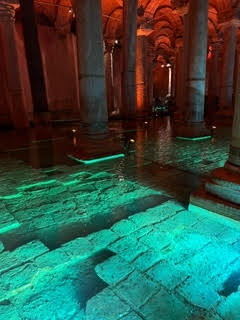
The diary of world travelers – Larry and Kathy from their 2024 trip to the Mediterranean
Athens
We arrived at our Viking Ship at 8:00 PM in Athens, Greece 25 hours after we left POC, the highlight being the Baileys Irish Crème I talked the flight attendant into pouring into my 1/2 eaten ice cream cup I had for desert. Yum, yum, good!! Greece only has 11 million people and 5 million live in the Athens area. Our excursion today was a drive to the ancient city of Corinth and the Corinth canal. The canal was first thought of in the 7th century BC, it was abandoned and an overland portage road was constructed and they towed the ships over the isthmus. Multiple attempts to dig the canal through the limestone were attempted and failed until 1893 when it was completed. It is too narrow for modern ships being only 80 ft wide at water level. But it saved miles of travel around Greece to the Mediterranean Ocean making the area one of the most used for all commerce. There were almost 500,000 people in Corinth but much of the old city is covered by the new city and is unavailable for excavations, the city center has been uncovered and the fountains referred in the Bible by the Apostle Paul have been uncovered. Corinth’s original name was Sparta.
This area was the home of Alexander The Great and his huge Greek Macedonia Empire. Greece is known as the birth place for Democracy and modern Western Civilization, Philosophy, Theatre, Science, Mathematics, Drama and the Olympic Games.
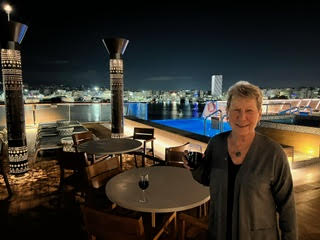
Crete
Greece has 6,000 islands. Crete is the largest island of Greece. It can trace civilization back to 7 century BC and now has about 500,000 inhabitants.
The island has 5 mountain ranges, the height at 8,000 feet and snow covering the peaks. It produces a lot of olives (Greece has 140 million olive trees), grapes and raisins. It is very pretty and green and covered with olive trees and vineyards ( it was once covered by forests but while under the rule of the Venetians they used the trees to build 1,000s of ships and under the Ottoman Empire the forests were burned to rut out rebels). The apostle Paul stopped here and left his disciple Titus to carry on the work (90% of the people in Greece are Greek Orthodox).
Our tour today took us through the mountains to the archaeological sites of the Palace of Knossos and the village of Arolithos. The Palace of Knossos relics date back 4,000 years and the village below it 7,000 years. It is also known for its mythology, Zeus was born here in a cave up in the mountains and the Palace of Knossos was the setting for Theseus (who was in love with the kings daughter Ariadne) had to fight the Minotaur (half bull and half man) in a labyrinth for her hand, she gave him a ball of string to unwind so he could get out. Much of the palace has been damaged by multiple earthquakes on the island.
It is cool here 49 to 65 so we didn’t spend any time at the beaches. When we got on the bus it was very quiet, after a couple of minutes of silence I whispered to the couple in front of us “It sure is quiet in here, do you know the person who died?” The lady laughed but the husband said “With the age of all of those on the bus, that’s not funny”. It did break the ice and we visited until the funeral.
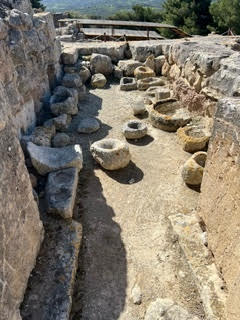
Rhodes
Today was quite a day. It started with a walk thru the Grand Masters Palace located in the old medieval city of Rhodes. The city has 4 sets of walls with motes in between that were used a killing fields . It was built in 1310 by The Knights Hospitallers and was not ever defeated until 1522 when the 7,000 Knights held out against 300,000 from the Ottoman Empire for 6 months and were allowed to leave. The Palace of the Grand Master is magnificent, it was blown up when a powder room exploded and collapsed in 1855. It was rebuilt by the Italians to be the summer home of Mussolini 1940. It had 190 rooms and He never saw it.
Rhodes was the home of the mythical sun god Helios and the home of one of The 7 wonders of the ancient world The Collossus of Rhodes (a 108 ft bronze statue of the Sun god Helios at the entrance of the harbor, it was the same size as the Statue of Liberty, made of bronze 280 BC).
We then took a 1 hour bus ride to the other side of the island to the beautiful White House city of Lindos and the cliff top acropolis where the temple of Athena sat. We had to walk down into the city and then 280 steps up to the top of the acropolis. It was quite a view.
Today was quite a day.
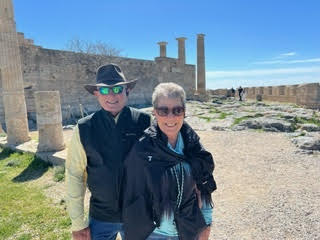
Troy (Canakkale)
Turkey
Troy is a seaport in Turkey that sets at the narrowest part of the Dardanelles Straits that connects the Sea of Marmara (the Asian side of Turkey) to Sea of Aegon (the Europe side of Turkey) and is of major importance commercially and militarily, it is the major sea access for Russia and Ukraine ship from the Black Sea to the Mediterranean. From Greek Mythology Helle, the daughter of Athamas, drowned in the Dardanelles Straits in the legend of The Golden Fleece. Also the Greeks used a great wooden horse to invade and destroy Troy. The Trojan Wars, 12th and 11th BC , happen when Greece attacked Troy because Paris of Troy took off with the Queen of Sparta which led to the deaths of Achilles, Ajax and Hector, thus the ruse of the Trojan Horse. There are actually 10 ruins of Troy because they kept rebuilding on top of the previous generation. Troy dates back over 6,000 years and was fortified by a 30 ft high-18 ft wide wall. Earthquakes are a major factor in the ruins lover this part of the world.
(The Trojan horse was a gift from the studio from when they filmed Troy with Brad Pitt. They said after the movie tourism went up 100 times.)
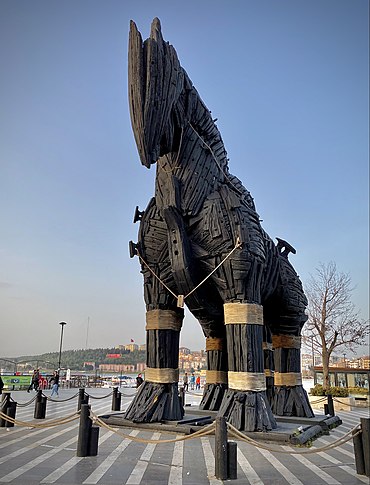
Ephesus
The coast of Turkey is less than 7 miles from the coast of Rhodes, Greece, yet the Greek/Roman city of Ephesus is Turkish and the island off its coast in Greek, it makes being neighbors difficult. Turkey is known as “The Cradle of Civilization, it is the bridge between Asia and Europe. Because of its location it has been invaded by many different civilizations: Lucian, Persian, Greek, Roman, Byzantine and Ottoman , conquered and left in ruins. The Great Temple of Artemis (one of the 7 wonders of the ancient world) and Theater Basilica of St John in Ephesus and Hagia Sophie in Estanbul are the relics left behind. Ephesus is the best preserved ruins of the Greco/Roman rule. Ephesus played a major role in the expansion of Christianity with St Paul launching many of his missionary journeys from here and it is the finally resting place for Mary, the mother of Christ.
Although it is now in Turkey it was one of the most important and oldest Greek cities.
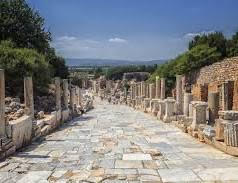
Istanbul
Half of Istanbul sits on the European continent and half on Asian continent, separated by the water of the Bosporus Straits. Twenty million people live there while the population of Turkey is 87 million.
Built by Constantine the Great in the forth century and called Constantinople, it was proclaimed the capital of the Eastern Roman Empire (Byzantine Empire), he legalized Christianity and is responsible for its spread. In the 14th century it fell to the Ottoman Empire, they converted Grand Christian Cathedral (Hagia Sophia) into an imperial mosque. They revitalized the city into an imperial city and were tolerant of any people willing to come there and pay taxes. During WWI an ethnic cleansing of the city’s Christians occurred. 1919 to 1922 the Turkish War occurred and the Ottomans were defeated and thrown out and independence declared.
The port of entry for the port is spectacular, located under water and below sea level, it can hold at least 40 buses and still look sterile. Dogs on the street neutered, tagged, released and fed by everyone, they all look fat and lazy. Cats are everywhere.
The Black Sea is 5 ft higher than the others because of freshwater flowing in so the current is always toward the Mediterranean ocean and is very strong. The Straits of Bosporus are so narrow they allow boat traffic to go only in one direction for 12 hours then switch to the other.
Kathy went on the tour today of Hagia Sophia mosque constructed in 532 AD and a walk thru the old city. Tomorrow we move to a hotel for 2 days in Istanbul.
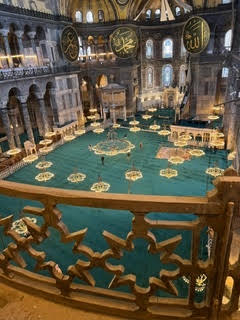
Istanbul II
Last day in Istanbul. Yesterday we disembarked from the ship and did a full day tour then we sat and had coffee while everyone went to the Hagia Sophia, but ended up walking thru The Blue Mosque and The Basilica Cisterns. (We are about through with Cathedrals and Mosques) but the Basilica Cisterns were incredible. Built in the 6th century to store water for Constantinople, 60 ft deep and holding 20 million gallons of water (2 football fields 60 ft deep) it was built by 7,000 slaves and is only one of the cisterns in the city. They have a metal grated pathway to walk thru the cistern that replaced the boats that they used to use for tours and the changing colored lights make it a beautiful place to see. They have concerts there and one was in process while we were there, definitely a highlight of our time in Istanbul.
